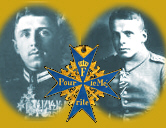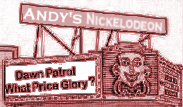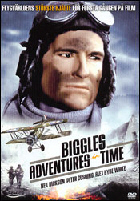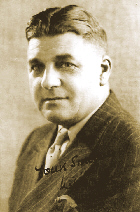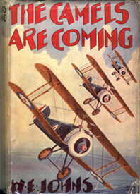
January 2006 |
Access Archives |
|
TRENCH REPORT: Here's my end of the year review. The number of unique visitors to the Trip-Wire each month is now at 16 - 17,000 and is growing. The most frequent request I receive is to start providing a printed version of each issue. But, that simply would be impossible. On the surrounding pages, you will find 12 major and minor articles and 21 photos. However, there are also hyperlinks to 30 other articles and websites. I'm afraid the Trip-Wire is a creature of the internet. Even if I could get permission to publish all the linked material, it would take me more than a month to produce a single issue which would be well over 100 printed pages.
Here, though, is one area where I think we can improve. I recently re-read all the previous issues of the Trip-Wire. One area where I saw a deficiency is in the coverage of the classic "signature" battles of the war. In this issue, to help correct this, well-known battlefield expert Tony Noyes has joined our list of contributors. In his Battle Diary Tony will give month-by-month accounts of the greatest struggles of the Great War. In accordance with our 90th Anniversary series, in this issue we begin with the Preluce to Verdun. Next month Tony's Battle of the Somme diary will commence and will run concurrently with the Verdun series for the rest of the year. I want to thank all of you who have sent messages of advice and encouragement in 2005 and wish all our readers a happy and productive 2006. MH 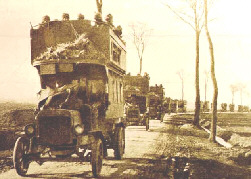
Indian Troops Moving to the Front
|
||||||||||||||||||||||

| Special Feature Germany's War Experience |
- The Kaiser and his Court [Book Review]
- Germany's First Cryptanalysis On The Western Front
- Bread Rationing in Berlin
- Victory myths and the Battle of Tannenberg
- Censored Photos in Germany
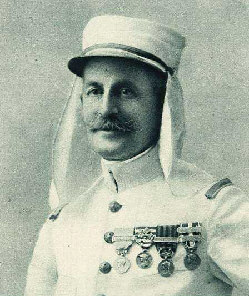
General Maurice Bailloud
Succeeded Gouraud as French Commander at Gallipoli. Clashed with Ian Hamilton and moved his forces to Salonika. Died in air crash.
New at the Websites of the Great War Society and Our FriendsClick on Title to Access |
| At Great War Society Sites At the WFA-USA |
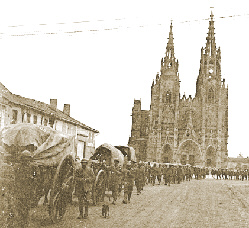
Where is this?
Italian troops on the March
Italy or the Western Front?
(email)
The entire collection of the Doughboys' newspaper, Stars and Stripes, is available at the website of the Library of Congress. (link) The definitive work on the newspaper which which was staffed by such journalistic luminaries as Harold Ross, Alexander Wolcott and Grantland Rice, The Stars and Stripes [Greenwood Press, 1984] was written by Great War Society member Alfred E. Cornebise.

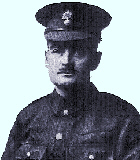 |
While shepherds watched their flocks
by night
All seated on the ground,
A high explosive shell came down
And mutton rained around.
GREAT WAR 2006 EVENT CALENDAR | |
|
Churchillian Society At the Pacific Union Club, San Francisco February 4 (email) | |
|
Comprehensive Double Calendar Scheduled Throughout 2006 (link) | |
|
Bay Street Armoury, Officer's Mess At Victoria BC March 10-12 (email) | |
|
Baltimore, MD April 1 (email) | |
|
Popular Culture Newcastle Inst. for the Arts & Social Sciences March 31 - Apr. 2 (link) | |
|
Aurora, Colorado May 19-21 (link) | |
|
Hilton Garden Inn, Tampa North August 16 (link) | |
|
Email Response |
|

Thanks to Ambassador Len Shurtleff for this: Senate Rule 22 providing that 60 votes are needed to end a filibuster dates back to World War I and the threat presented by Imperial German resumption of unrestricted submarine warfare in early 1917. Specifically, the rule was adopted after 11 Senators ("a little group of willful men" in Woodrow Wilson's words) took advantage of the traditional rule of unlimited debate to prevent a vote on a bill to authorize arming of American merchant vessels as a deterrent to German U-boat attack. The House had already passed the bill by a comfortable margin of 403 to 14). Later in the spring of 1917, the newly-elected Senate adopted a bill providing that a two-thirds vote was needed to overcome a filibuster. This was amended to three-fifths (60 votes) in 1975. The arming of American merchant vessels proceeded apace despite the failure of this legislation when Secretary of State Robert Lansing advised Wilson that he had the executive authority to take action without congressional approval.
|

I had entered the holocaust still childish and I emerged tempered by my experience, but with my illusions intact, neither shattered nor cynical.
Anthony Eden,
Future British Prime Minister
Another World
We have received announcements of the passing of three World War I veterans:
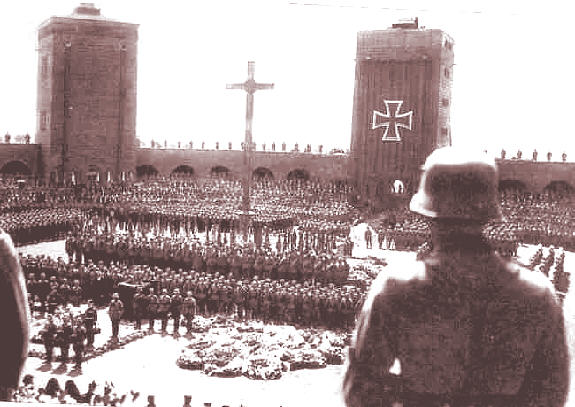
State Funeral of Paul von Hindenburg, Tannenberg War Memorial, August 7, 1933.
Key Step in Hitler's Ascendency to Power, But Note Absence of Swastikas (article)

|
Report on Innocence Slaughtered
|
The conference was well attended with 112 registered participants mostly from UK, Belgium, Netherlands and Germany, but India, Israel, Iran, Norway, USA (3) and Canada were also represented. The program was under the direction of Dominiek Dendooven and was moderated with old world courtly charm by Prof. Dr. Koen Koch. The initial lectures were devoted to the first use of chemical weapons (WMD'S) by Germany on April 22, 1915 at Langemark, Belgium. This conference was about men--not materials--as is not often the case with some museums.
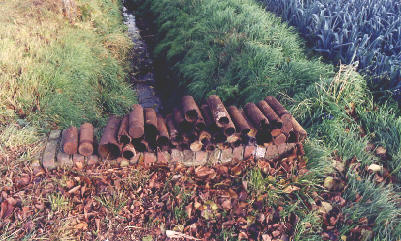
Shells Combed from Flanders Fields
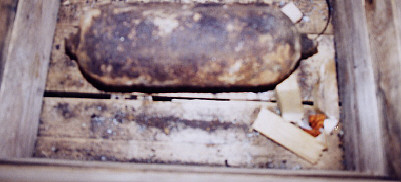
A "Livens" Shell Awaiting Disposal
Contains 8 Liters of Phosgene
The afternoon of the last day was a tour of battleground where gas was used and a trip to Belgian Army Ammunition Disposal unit (DOVO). Each year 250 tons of ordnance is still removed from Flanders' fields. Of this quantity, 5% are chemical weapons(phosgene and mustard gas) which are very carefully separated from the explosive charges. The liquid is shipped to an incinerator in Antwerp. All this is done in modern state of art decontamination centers by personel in full NBC outfits. Now, I know why I carried a gas mask in Vietnam . The fear unleashed that fateful day persists right to today whether its use is real or threatened. There is a lot more about this event which I am willing to share with anyone interested at jvs@surfglobal.net
|
in the 21st Century |
- Honorary Degree for 107-Year-Old Veteran
- New Tunneling Under the Western Front
- Story of a French Café
- Last Tommy to have State Funeral
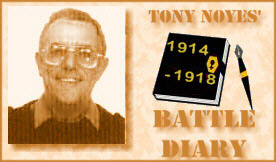
|
Verdun
|
Click Here to See a Large Battlefield Map of Verdun
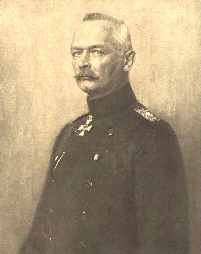 Falkenhayn: The Architect |
In December Colonel Driant was commanding two battalions of light infantry in forward positions approximately in the middle of the front to be assaulted. He was very unhappy with the condition of the positions and complained bitterly in August 1915, from his position as a Deputy (a member of Parliament), that all was very unwell. His complaints brought forth an investigation by the Army Council which found in his favour. Joffre was very unamused.
However, and as a direct result of these events, in late 1915 supplies grudgingly began to make their slow way to the front at Verdun. At the same time incoming situation reports from the French front lines spoke of increasing evidence of the huge build up behind the German lines. French Intelligence said that these reports were not feasible or else they were untrustworthy. They did nothing. Colonel Driant fumed at the continuing incompetence and had built his own defensive works exactly in accordance with the field manual instructions of 1907 to defend his position in the Bois des Caures. There was little more he could do to improve his situation. In daytime the front was quiet, generally as it had been throughout 1915, when Joffre had ordered the guns to be stripped from the Forts on the surrounding hills for use in Champagne. There was little movement on either side, sniping was at a low key, the artillery was quiet and there was an amount of "live and let live". Not a bad place to be stationed if one had to be living in a hole in the ground, wishing one was at home with the wife and kids.
If you would like to visit these fields of memory for a detailed tour, please email Tony Noyes or Christina Holstein to discuss your requirements without obligation.
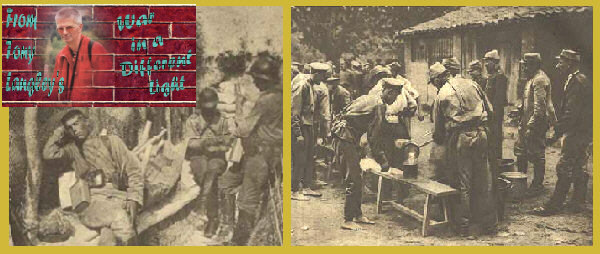
Russian Troops on the Western Front
Someone Thought This was a Swell Idea at the Time
Click Here to Visit War in a Different Light
Not Forgotten's aim was to explore the background of some of the names on these memorials and bring these stories back to the forefront, emphasising the importance of individual experiences, and the relative importance of some of these men, on personal, national and sometimes universal levels. When the programme focused on these latter two categories, for example the first Black Officer in the BEF, Walter Tull, it was careful to choose names of those who had made an impact at the time, or were considered media celebrities at the time, rather than focusing on more well known voices to a later audience. 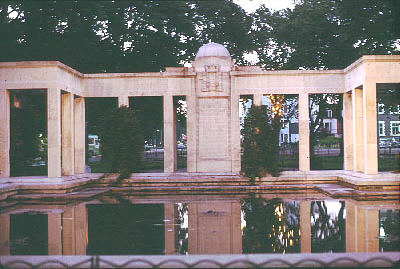 Brighton War Memorial. |
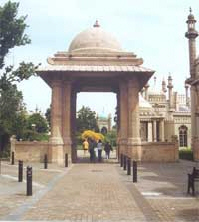 Memorial to Indian Soldiers Also Forgotten |
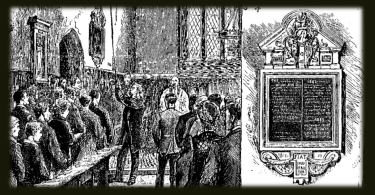
Unveiling of the Roll of Honour at Brighton College
Click on the icon below to visit her site.
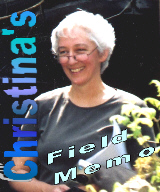 |
A Surviving Trench and
Bunker Network
By Christina Holstein
Guides to the Western Front, like myself, are often asked if there are surviving trenches that can be visited still. The answer is, yes there are -- if you know where to look. Here is one example:
This is a series of photos taken at the end of October 2005. They were all taken in Parisaux Wood which lies to the east of Verdun, not far from the town of Etain. This is in the area held by the German 50th Reserve Infantry Division throughout the war. The southern edge of Parinsaux Wood was the German front line in the early days of the war. The image below on the left shows a trench which runs all along this southern edge.
Later, however, the wood became a backup position and in 1917 a number of concrete blockhouses were constructed there. Here is a selection of photos from the large number of blockhouses that can be seen. They are all in good condition.
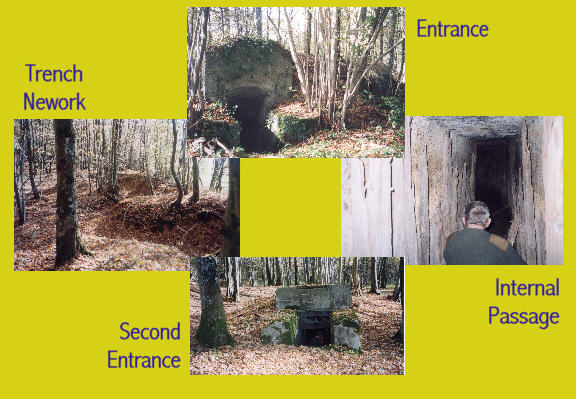
Andrew Melomet, Proprietor of Andy's Nickelodeon will answer your Great War film or video inquiry. He is also soliciting your recommendations for the WWI Filmography he is compiling for our readers. Just click HERE. |
| The following are thanked for their contributions to this issue of the Trip Wire: Sean McLachlan, David Smith, Donna Cunningham, Christina Holstein,Tony Noyes, Esther MacCallum-Stewart, Andy Melomet, Sidney Clark, Len Shurtleff. Saki's poem was found at the WWI Document Archive. Until next month, your editor, Mike Hanlon. |
Membership Information  Click on Icon |
SUBSCRIBE TO THE TRIP-WIRE (Or Send it to a friend.) (Or send us a comment on the TRIP-WIRE) CLICK HERE TO CONTACT US VIA EMAIL |
For further information on the events of 1914-1918
visit the Directory Page of |

